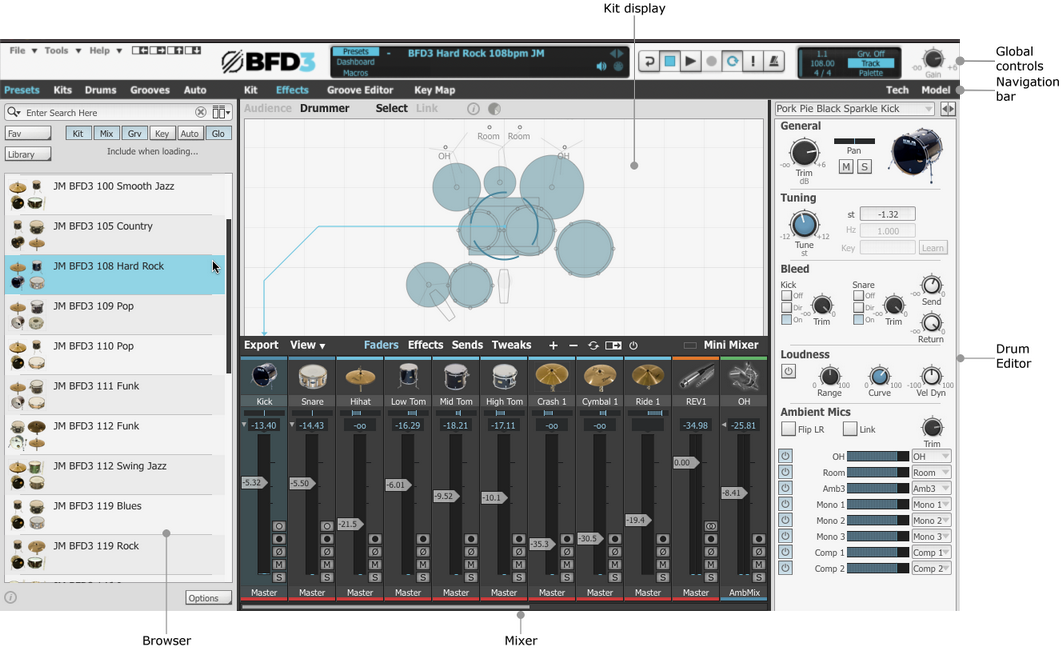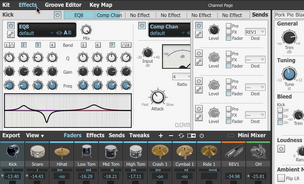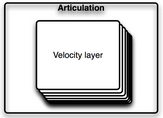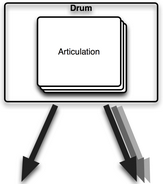BFD3 layout

Global controls and navigation bar
The upper part of the BFD3 interface features a number of Global controls that relate to working with and managing BFD3.
The navigation bar features buttons to access various parts of BFD3, described below.
Browser
The Browser panel is used to load sounds and Grooves into BFD3. Using the tab buttons in the navigation bar at the top of this panel, it can be switched to browse for Presets (entire BFD3 states), Kits (configurations of Drums in slots), Drums (individual percussive instruments to load into the current kit) or Grooves (patterns or sequences that play BFD3's sounds).
This panel is also switchable to the Automation panel using the Auto button.
The Browser panel can be hidden by clicking the currently active tab button. Click any of the buttons to make it visible again.
To get started with BFD3, double-click any item in the Presets browser to load an entire mix-ready preset.
Kit display
The Kit display shows the physical layout of the kit, which is comprised of a number of Drum slots.
The currently selected Drum slot is highlighted - click any slot to select it and audition the Drum.
The Kit display is also used for the Link function which allows you to layer Drums together so that they are played at the same time.
Drum Editor
The Drum Editor contains a wide array of parameters for tweaking the sound and response of the currently selected Drum and contains 2 pages, accessed by the Tech and Model buttons in the navigation bar.
Clicking the currently active button hides the Drum Editor panel entirely. Click either button again to display it if it is currently hidden.
•Click the Effects button to show the Effects Editor |
Mixer The mixer area represents a comprehensive mixing engine for the audio channels within BFD3's sounds. A Drum (or Drum slot if it is empty) can be selected by clicking its mixer channel. Effects Editor The Effects Editor is shown by clicking the Effects button in the main BFD3 navigation bar. It displays the currently selected mixer channel's effect slots and Send controls. |
Additional pages and panels
The following pages and panels are accessed using buttons in the navigation bar:
Groove Editor
The Groove Editor is displayed by clicking the Groove Editor button. This page represents the entire Groove engine - it shows the Groove Palette, Groove Editor and Groove FX sections.
Key Map panel
Click the Key Map button to display the Key Map page, used for creating and editing custom Key Map setups for assigning MIDI notes to Drum articulations.
This page is also useful for checking the layout of the current Key Map.
Automation panel
Click the Auto button above the Browser to display the Automation panel in place of the Browser. This panel provides control over assigning MIDI CC, note and host automation parameters to BFD3 controls for remote control purposes.
Click any other Browser tab button to exit the Automation panel.
How to approach the BFD3 interface
The philosophy of BFD3 is to recreate all aspects of studio drum recording and production within your computer.
•The Kit display and Drum Editor can be considered as the drumkit in a studio.
•The Mixer and Effects Editor represent the control room with a mixing console and outboard processing.
•The Groove engine and Key Map panel are related to the 2 ways that BFD3's sounds can be played, in effect representing the drummer.
Working with BFD3
The basic workflow in BFD3 can be considered in the following steps:
1. Load a BFD3 Preset, a kit or assemble a kit from individual Drums using the Browser.
2. Use the Drum Editor to modify the underlying drum sounds.
3. Use the Mixer to either process the sounds internally or to route microphone audio channels (either completely discretely or after some submixing if you require) into individual channels in your host/DAW for further processing or recording.
4. Play the Drum sounds with MIDI notes or with the Groove engine.
5. The resulting audio can be recorded by BFD3's audio export functions or, if you've routed channels discretely into your host, you can use its own recording functions.
Please consult the opening sections of chapter 2 and chapter 3 for a more detailed guide to the main aspects of this workflow. See chapter 4 for a full guide to operation of the Groove engine.
Important concepts in BFD3
Drums, articulations and velocity layers
|
An articulation is a type of way of hitting a drum, cymbal, hihat or other percussive instrument. The following are examples of articulations: •striking the main surface, bell or edge of a cymbal •striking the main head of a snare or playing a rim-shot or sidestick Within BFD3, an articulation is the smallest addressable entity. It is itself composed of a series of individual samples, called velocity layers, due to the fact that they represent a dynamic graduation from quiet to loud, designed to be addressable by the MIDI note velocity range of 0 (silent) to 127 (loudest possible sound). Each velocity layer sample is actually composed of multiple direct and ambient mic channels: audio channels captured by multiple microphones. See below for more details on mic channels. Articulations can be triggered in 2 ways: •MIDI notes assigned to articulations with the Key Map •Groove engine events Articulations can also be triggered by audition previews in various parts of BFD3 - the Drum Editor lets you preview all articulations in a Drum, for example. BFD3's Drums contain a variety of articulations - see the section below for a list of available articulations.
A Drum is composed of 1 or more articulations, and is the name given to any instrument within the kit in BFD3, whether it is a kick, snare, tom, cymbal, hihat or percussion instrument. Snares contain between 5 and 7 articulations and hihats contain up to 11 while other instruments such as toms may feature only 1. |
||||
Mic channels
When Drum articulations are triggered by incoming MIDI or Groove engine events, the audio generated is fed to BFD3's mixer in the form of Direct mic channels and Ambient mic channels. Direct mic channels contain audio signals recorded by microphones close to the Drum, while Ambient mic channels contain audio signals recorded by stereo mic pairs over the kit (Overhead, or OH) and at various positions in the recording room (Room, Amb3). BFD3's library also contains further mono room and hardware-compressed direct mic channels for increased mixing flexibility.
|
|
Direct mic channels from each Drum are represented by an individual Drum channel on the BFD3 mixer.
Kicks and Snares feature multiple sub-mics which are mixed into single Kick and Snare 'mix' channels. These channels, along with Tom channels, can also contain bleed and spill signals from other Drums, depending on their Bleed settings. |
Ambient mic channels of each type - OH, Room, Amb3 etc. - from all Drums are mixed together into the OH, Room, Amb3 etc. channels in the BFD3 mixer.
These Ambient mic channels are mixed into the Ambient Mix channel. |
For further details on mic channels, bleed and spill signals and other aspects of mixing within BFD3, see chapter 3.
Articulations in BFD3's Drums
Note: the following list represents all possible articulations for each Drum. Not all included Drums include all possible articulations. Articulations also vary between different BFD-compatible libraries and expansion packs. BFD3 is capable of supporting all articulations - any Key Map assignments use an intelligent substitution system if a required articulation is not present in the currently loaded Drum.
Kicks •Hit [Default] •NoSnare
Snares •Drag •Flam •HalfEdge •Hit [Default] •Rim Shot) •SS (SideStick) •Rim Click
Hihats •Closed Shank •Closed Tip [Default] •Half Shank •Half Tip •Open Shank •Open Tip •Quarter Shank •Quarter Tip •Splash •ThreeQ Shank •ThreeQ Tip •Bell Tip •Splash |
Toms •Hit [Default] •Rim •Rim Click
Cymbals •Edge •Bow [Default] •Bell
Percussion •Hit •Alt Note: Some Percussion Drums are classified as Snares, due to possessing more than 2 articulations - for example, the included Carroll Sound Tambourine which features 5 articulations. Drums such as these can be loaded in the same way as any other Percussion Drum into a Percussion slot. However, the additional articulations are not available via MIDI notes until they are assigned in the Key Map panel. They are, however, always accessible in the Groove engine. Alternatively, these drums can be loaded into the Snare slot if you prefer, in which case the articulations are already mapped to MIDI notes. An additional Snare slot can also be used, although all its articulations would need to be mapped using the Key Map panel. |



